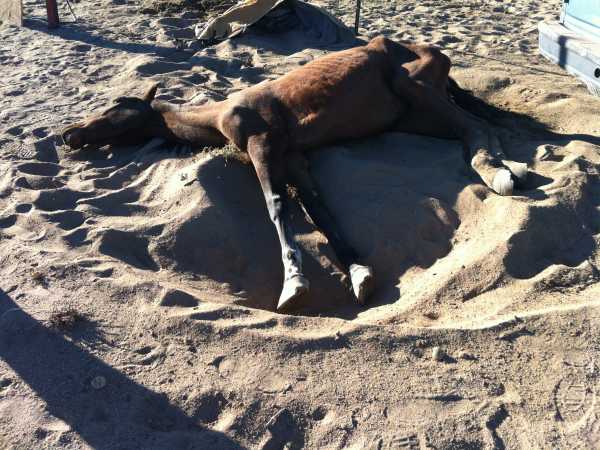LARGE ANIMAL RESCUE SKULL SESSION
|
| THE MARE IS DOWN! |
|
Background.
Having literally thousands of personal horses living in the county, we regularly get calls to check on declining or debilitated horses. Over time we've learned a great deal about assessing these animals. Some times we intervene. Sometimes we attempt a rescue to better evaluate the condition of the horse. Sometimes it's best to euthanize the animal. Critical to our learning is that oftentimes what appears to be a case of simple lack of proper nourishment could actually be a symptom of an unusual causal factor. In this particular incident there are clues to be found that should help guide the decision making process with this horse.

The actual incident. Some novice horse owners acquired a rescue mare off Craig's list. The horse was not in very good condition. The mare was about 12 years old. On the advice of horse-owning neighbors, they transitioned the horse from grass hay to alfalfa and provided high protein complete feeds. In spite of this diet, the horse appeared to decline. You are called out to neighbors' report of a horse down. You respond to find the situation photographed above. The mare can not quite get to her feet on her own. You initially determine that a veterinarian was called the day before but didn't arrive. (There was confusion as to the address and the "neighbor-helper" who contacted the vet subsequently turned her mobile phone off.) The mare recently has been extremely thirsty, consuming three or more times her normal water intake, even though the weather has been cooler. The mare's legs are stocked up and are oozing serum from her lower legs, particularly where skin pigment is light. The horse owner was treating these areas with Desitin and wrapping the legs. The horse's hooves were very long in the toe. (The owners' horse trimmer moved out of state and they were on a wait list for another barefoot trimmer.) The horse was discovered by her owners after leaning against a wire fence and actually falling through it. The horse could get to a sternal position but not rise on her own. In the sternal position, the horse showed good appetite and drank water heartily. (The water was metered to the horse in small quantities.) The veterinarian was contacted, a correct address given, and would be available in a few hours. (Sometimes we're lucky to get a veterinarian out on the same day out here.) Skull Session Questions
Please post your answers to the Technical Large Animal Emergency Rescue group. Note: Those of you with veterinary training, please wait for other comments to be posted and ideas to be presented before posting the likely diagnosis. However please feel free to recommend appropriate field actions. Skull Session rules. Please post your answers independently of the answers posted by others. Please also recognize that there can be varying perceptions as to what these scenarios involve since these problems are being solved using limited information. The values of these sessions include the various approaches the participants may suggest based on their varying perceptions of the problem, so it's not a matter of someone being right and someone being wrong. Please read, think, and post your answers to the TLAER Facebook group based on your perception of the problem presented. Continue to How the Incident was ResolvedGo to Skull Session IndexReturn to the Strike Team LRTC Page |
This material is intended for the use of the Technical Large Animal Emergency Rescue (TLAER) Facebook Group. TLAER is a trademark of Technical Large Animal Emergency Rescue. |